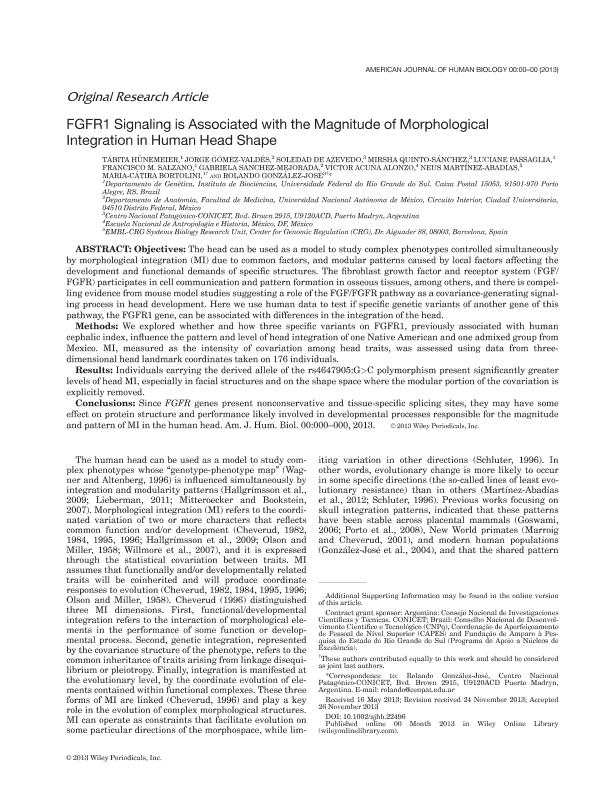Mostrar el registro sencillo del ítem
dc.contributor.author
Hünemeier, Tabita
dc.contributor.author
Gómez Valdés, Jorge
dc.contributor.author
de Azevedo, Soledad

dc.contributor.author
Quinto Sanchez, Mirsha Emmanuel

dc.contributor.author
Passaglia, Luciane
dc.contributor.author
Salzano, Francisco M.
dc.contributor.author
Sánchez Mejorada, Gabriela
dc.contributor.author
Acuña Alonzo, Victor
dc.contributor.author
Martínez Abadías, Neus
dc.contributor.author
Bortolini, Maria Catira
dc.contributor.author
Gonzalez José, Rolando
dc.date.available
2016-09-19T18:28:50Z
dc.date.issued
2013-12-10
dc.identifier.citation
Hünemeier, Tabita; Gómez Valdés, Jorge; de Azevedo, Soledad; Quinto Sanchez, Mirsha Emmanuel; Passaglia, Luciane; et al.; FGFR1 signaling is associated with the magnitude of morphological integration in human head shape; Wiley; American Journal of Human Biology; 26; 2; 10-12-2013; 164-175
dc.identifier.issn
1042-0533
dc.identifier.uri
http://hdl.handle.net/11336/7647
dc.description.abstract
Objectives: The head can be used as a model to study complex phenotypes controlled simultaneously by morphological integration (MI) due to common factors, and modular patterns caused by local factors affecting the development and functional demands of specific structures. The fibroblast growth factor and receptor system (FGF/ FGFR) participates in cell communication and pattern formation in osseous tissues, among others, and there is compel- ling evidence from mouse model studies suggesting a role of the FGF/FGFR pathway as a covariance-generating signal- ing process in head development. Here we use human data to test if specific genetic variants of another gene of this pathway, the FGFR1 gene, can be associated with differences in the integration of the head. Methods: We explored whether and how three specific variants on FGFR1, previously associated with human cephalic index, influence the pattern and level of head integration of one Native American and one admixed group from Mexico. MI, measured as the intensity of covariation among head traits, was assessed using data from three- dimensional head landmark coordinates taken on 176 individuals. Results: Individuals carrying the derived allele of the rs4647905:G>C polymorphism present significantly greater levels of head MI, especially in facial structures and on the shape space where the modular portion of the covariation is explicitly removed. Conclusions: Since FGFR genes present nonconservative and tissue-specific splicing sites, they may have some effect on protein structure and performance likely involved in developmental processes responsible for the magnitude and pattern of MI in the human head.
dc.format
application/pdf
dc.language.iso
eng
dc.publisher
Wiley

dc.rights
info:eu-repo/semantics/openAccess
dc.rights.uri
https://creativecommons.org/licenses/by-nc-sa/2.5/ar/
dc.subject
Fgfr1
dc.subject
Human Head Shape
dc.subject
Morphological Integration
dc.subject.classification
Genética y Herencia

dc.subject.classification
Ciencias Biológicas

dc.subject.classification
CIENCIAS NATURALES Y EXACTAS

dc.title
FGFR1 signaling is associated with the magnitude of morphological integration in human head shape
dc.type
info:eu-repo/semantics/article
dc.type
info:ar-repo/semantics/artículo
dc.type
info:eu-repo/semantics/publishedVersion
dc.date.updated
2016-09-14T17:37:55Z
dc.journal.volume
26
dc.journal.number
2
dc.journal.pagination
164-175
dc.journal.pais
Estados Unidos

dc.journal.ciudad
Nueva York
dc.description.fil
Fil: Hünemeier, Tabita. Universidade Federal do Rio Grande do Sul; Brasil
dc.description.fil
Fil: Gómez Valdés, Jorge. Universidad Nacional Autónoma de México. Facultad de Medicina; México
dc.description.fil
Fil: de Azevedo, Soledad. Consejo Nacional de Investigaciones Científicas y Técnicas. Centro Nacional Patagónico; Argentina
dc.description.fil
Fil: Quinto Sanchez, Mirsha Emmanuel. Consejo Nacional de Investigaciones Científicas y Técnicas. Centro Nacional Patagónico; Argentina
dc.description.fil
Fil: Passaglia, Luciane. Universidade Federal do Rio Grande do Sul; Brasil
dc.description.fil
Fil: Salzano, Francisco M.. Universidade Federal do Rio Grande do Sul; Brasil
dc.description.fil
Fil: Sánchez Mejorada, Gabriela. Universidad Nacional Autónoma de México. Facultad de Medicina; México
dc.description.fil
Fil: Acuña Alonzo, Victor. Escuela Nacional de Antropología e Historia; México
dc.description.fil
Fil: Martínez Abadías, Neus. EMBL-CRG Systems Biology Research Unit, Center for Genomic Regulation (CRG); España
dc.description.fil
Fil: Bortolini, Maria Catira. Universidade Federal do Rio Grande do Sul; Brasil
dc.description.fil
Fil: Gonzalez José, Rolando. Consejo Nacional de Investigaciones Científicas y Técnicas. Centro Nacional Patagónico; Argentina
dc.journal.title
American Journal of Human Biology

dc.relation.alternativeid
info:eu-repo/semantics/altIdentifier/url/http://dx.doi.org/10.1002/ajhb.22496
dc.relation.alternativeid
info:eu-repo/semantics/altIdentifier/url/http://onlinelibrary.wiley.com/doi/10.1002/ajhb.22496/abstract
Archivos asociados
